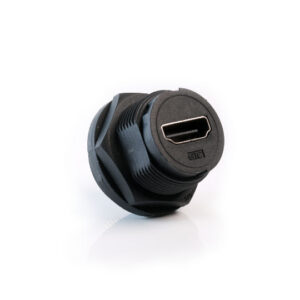Industrial HDMI Connectors
High Definition Multimedia Interface (HDMI) connectors are specifically designed to send uncompressed HD signals for both video and audio. HMDI connectors have become the most commonly used type of connector, and cables, for both professional and commercial AV applications. Generally, they are found within the home in products such as TV’s, DVD’s, Xboxes and PlayStations. Our rugged industrial HDMI connectors are version 1.4 and are environmentally sealed to IP67.
View Frequently Asked Questions about HDMI ConnectorsHDMI Series – Waterproof Input/Output Connectors
The HDMI series of waterproof input/output connectors from GT contact are highly ruggedised connectors sealed to IP67. The HDMI series panel connectors are rear potted giving protection to products even if the connector is unmated or sealing cap not connected....
View ProductFrequently Asked Questions about HDMI Connectors
There are a total of 5 different types of HDMI connectors however only 3 of these are in common use. These types are named A, B, C, D and E, Type A is the standard size or full-size HDMI connector found on TV’s and computer systems. Type C is a mini HDMI that can be found on some laptops and larger video cameras while Type D is a Micro HDMI often found on smaller cameras and portable systems. The other two are Type B which is a Dual Link HDMI connector that is larger than the standard Type A and Type C which is a special automotive connector, as mentioned previously Type B and Type E are not often found in general use.
HDMI cables suffer from signal loss at longer lengths, for this reason, it is generally accepted that a HDMI cable should not be longer than 50 foot or 15 meters in length.
There is no way to know what style of cable you have by looks alone unless this is printed onto the cable, the cable is labelled or you have the packaging. Using the cable on a system that tells you the resolution and the frequency (Hz), such as high-quality computer monitors, would be the only way to see the difference. For this, you would need to know the HDMI connector version of your system along with that of the monitor and the corresponding resolution shown would give you an idea of which style of cable you are using.
There are currently 8 different versions of HDMI connectors, these are generally broken down into 4 categories which relate to their speed and the maximum resolution they offer. HDMI versions 1.0, 1.1 and 1.2 are the oldest style which offers HD quality at 60p, while version 1.3 offers 2K resolution at 60p these are also known as standard HDMI cables. HDMI 1.4 increased the resolution to 4K but at only 30p which are known as high-speed cables, while 2.0 and 2.0b raised this to 4K at 60p and are known as premium high-speed cables. The latest iteration is version 2.1, these connectors can achieve 8K at 60p or 4K at 120p resolution and are known as ultra-high-speed HDMI cables.

